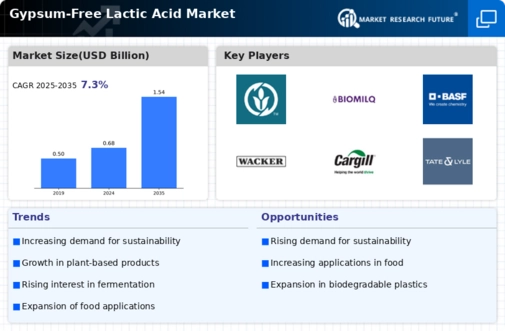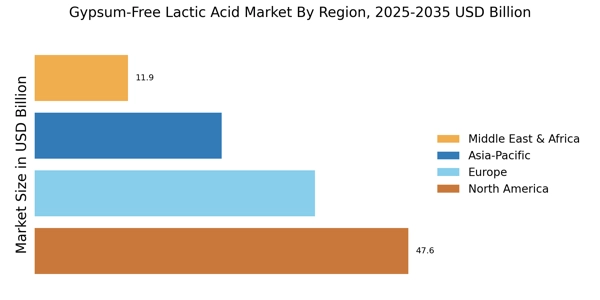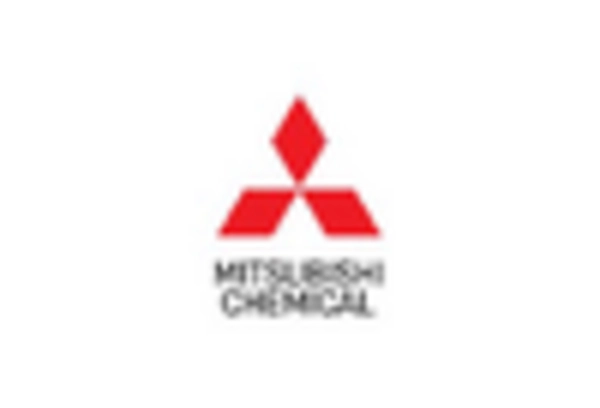Sustainability Initiatives
The increasing emphasis on sustainability within the chemical industry appears to be a pivotal driver for the Gypsum-Free Lactic Acid Market. As consumers and manufacturers alike prioritize eco-friendly products, the demand for lactic acid derived from renewable resources is likely to rise. This shift is evidenced by the growing number of companies committing to sustainable practices, which may lead to a projected market growth rate of approximately 10% annually over the next five years. The Gypsum-Free Lactic Acid Market stands to benefit from this trend, as it aligns with the broader movement towards reducing carbon footprints and minimizing environmental impact. Furthermore, regulatory frameworks promoting sustainable production methods could further bolster market expansion, as businesses seek to comply with stringent environmental standards.
Technological Advancements
Technological innovations in the production of lactic acid are likely to play a crucial role in shaping the Gypsum-Free Lactic Acid Market. Recent advancements in fermentation technology and bioprocessing techniques have enhanced the efficiency and yield of lactic acid production. For instance, the development of genetically modified microorganisms has shown promise in increasing lactic acid output while reducing production costs. This could potentially lead to a more competitive market landscape, as companies that adopt these technologies may gain a significant edge. Moreover, the integration of automation and digitalization in manufacturing processes is expected to streamline operations, further driving growth in the Gypsum-Free Lactic Acid Market. As these technologies continue to evolve, they may open new avenues for product development and application.
Expanding Applications in Bioplastics
The burgeoning interest in bioplastics presents a promising opportunity for the Gypsum-Free Lactic Acid Market. As industries seek sustainable alternatives to conventional plastics, lactic acid-based bioplastics are gaining traction due to their biodegradability and lower environmental impact. Recent studies suggest that the bioplastics market is expected to grow at a compound annual growth rate of over 15% in the coming years, driven by increasing regulatory pressures and consumer demand for sustainable products. This trend could lead to a heightened demand for gypsum-free lactic acid, as manufacturers look for eco-friendly raw materials to produce bioplastics. The Gypsum-Free Lactic Acid Market may thus find itself at the forefront of this transition, aligning with global sustainability goals.
Regulatory Support for Green Chemicals
The regulatory landscape increasingly favoring green chemicals is likely to serve as a catalyst for the Gypsum-Free Lactic Acid Market. Governments worldwide are implementing policies and incentives aimed at promoting the use of bio-based chemicals, which could enhance the market's growth prospects. For instance, initiatives that support the development and commercialization of sustainable products may lead to increased funding and research opportunities for companies in the lactic acid sector. This regulatory support is expected to create a more favorable environment for the Gypsum-Free Lactic Acid Market, encouraging innovation and investment. As businesses adapt to these regulations, the demand for gypsum-free lactic acid is likely to rise, further solidifying its position in the market.
Rising Demand in Food and Beverage Sector
The food and beverage sector's increasing demand for natural preservatives and flavor enhancers is likely to significantly impact the Gypsum-Free Lactic Acid Market. Lactic acid is widely recognized for its ability to enhance food safety and extend shelf life, making it a preferred choice among manufacturers. Recent market analyses indicate that the food and beverage industry accounts for a substantial portion of lactic acid consumption, with projections suggesting a growth rate of around 8% in this segment over the next few years. This trend is further fueled by consumer preferences shifting towards clean-label products, which are perceived as healthier and more natural. Consequently, the Gypsum-Free Lactic Acid Market is poised to capitalize on this rising demand, as manufacturers seek to incorporate lactic acid into their formulations.


















Leave a Comment